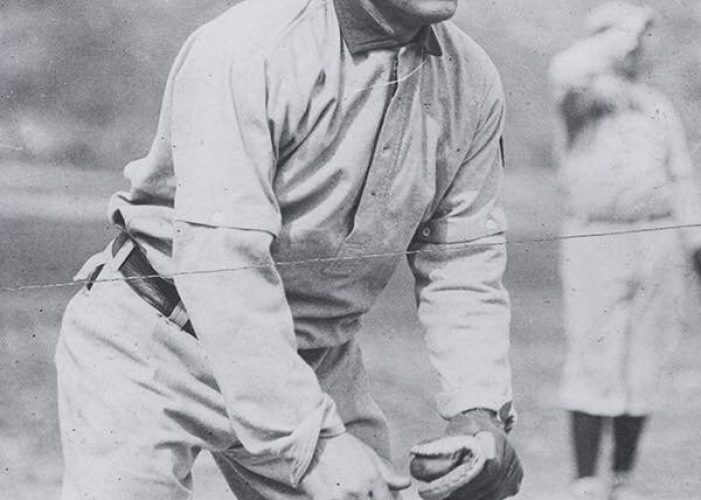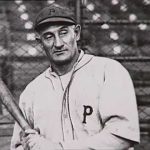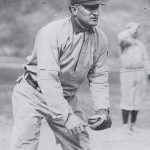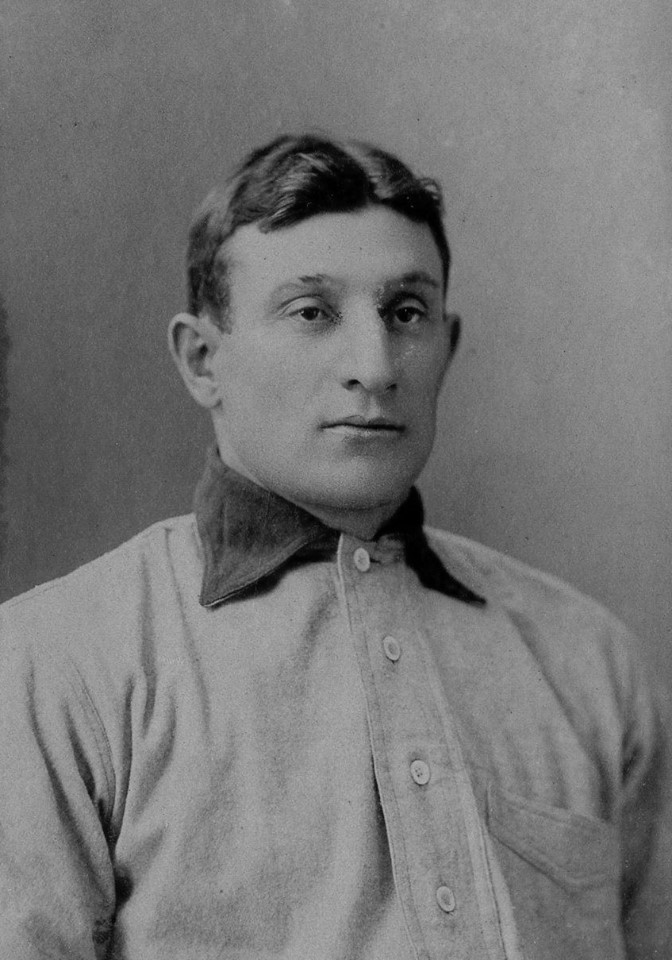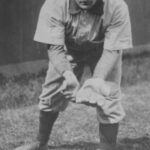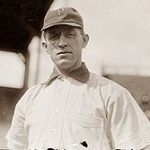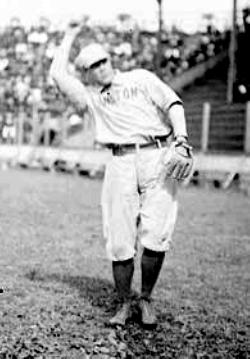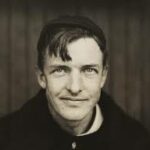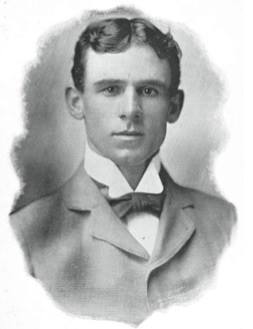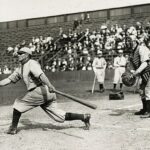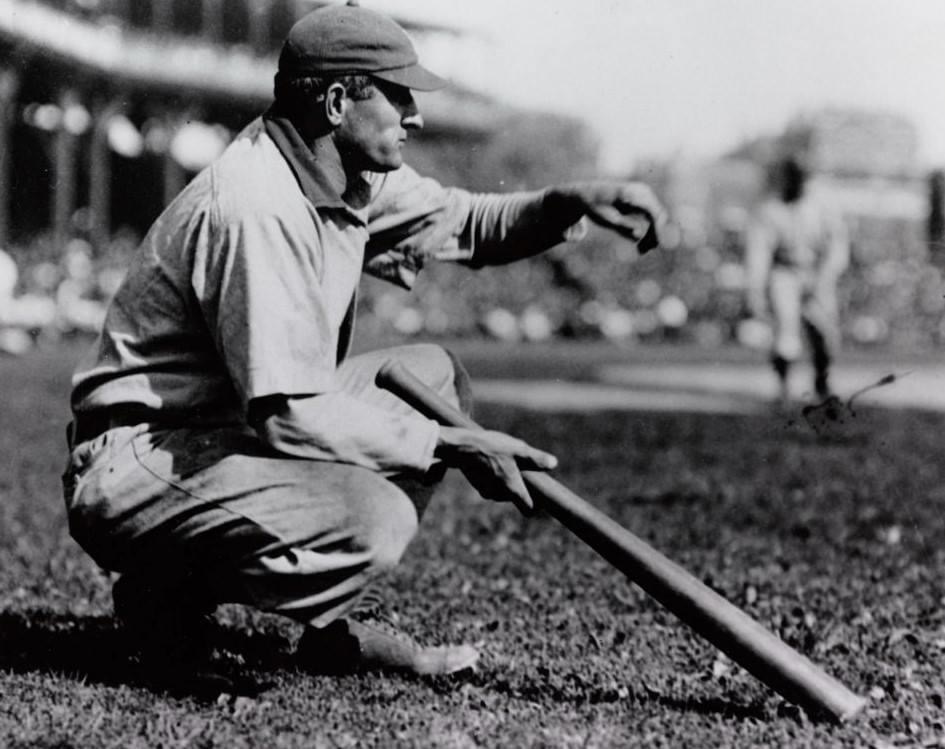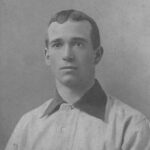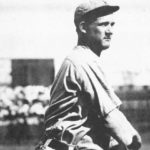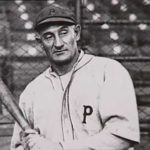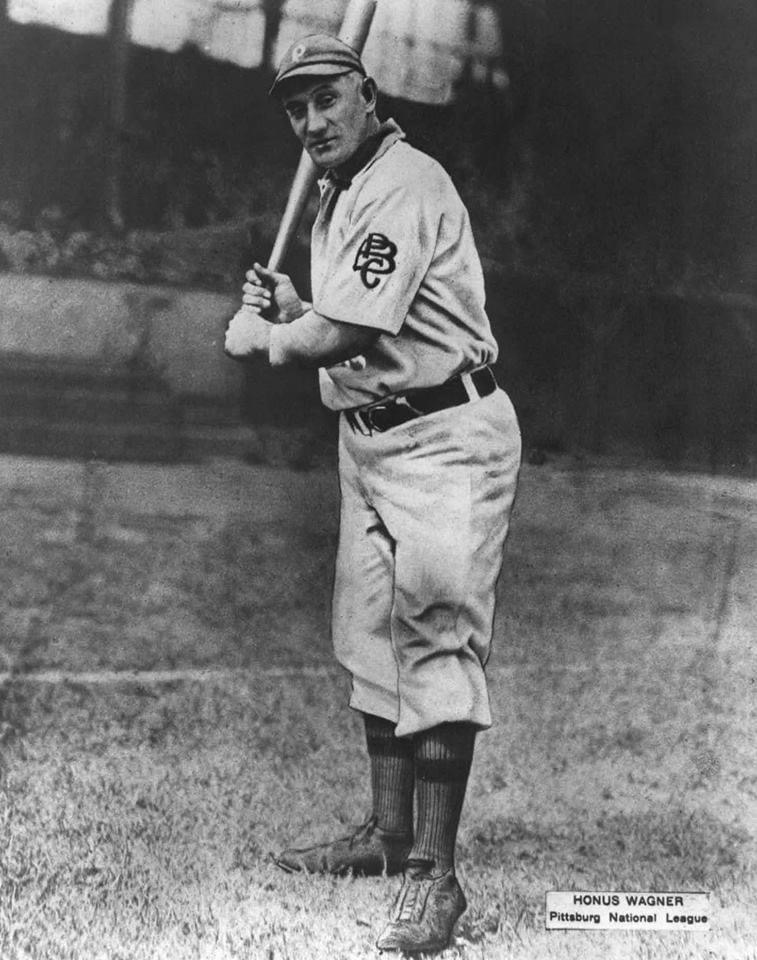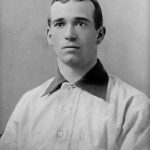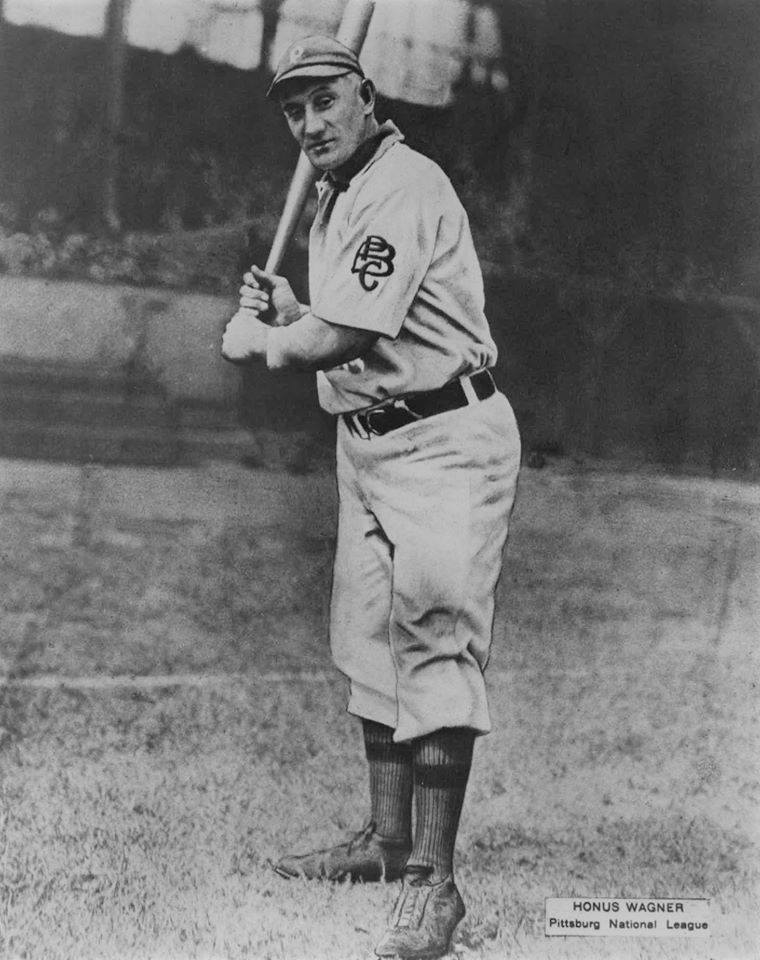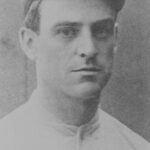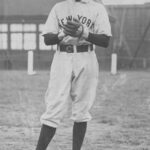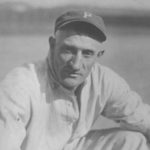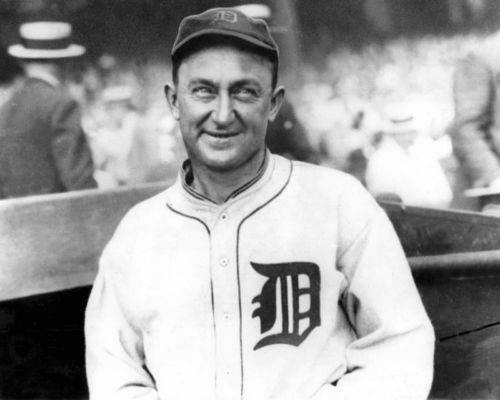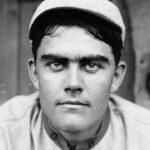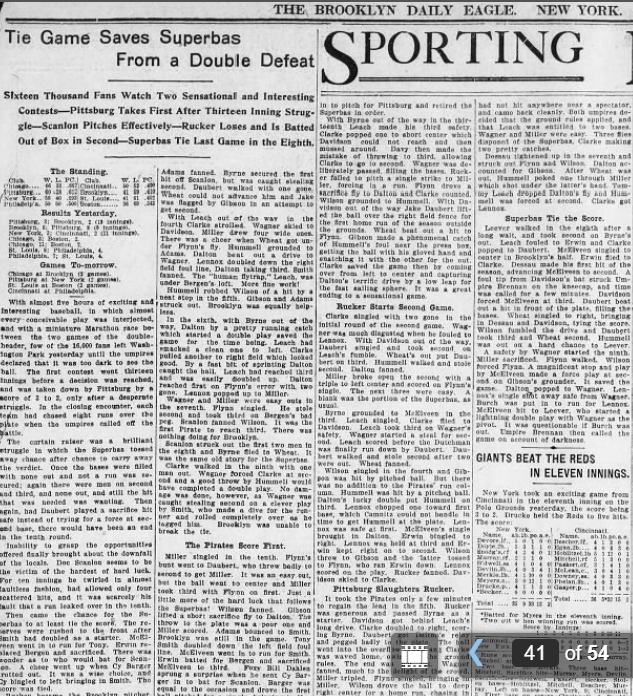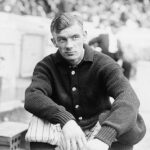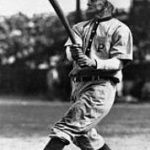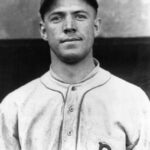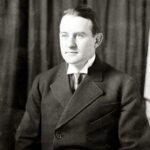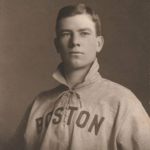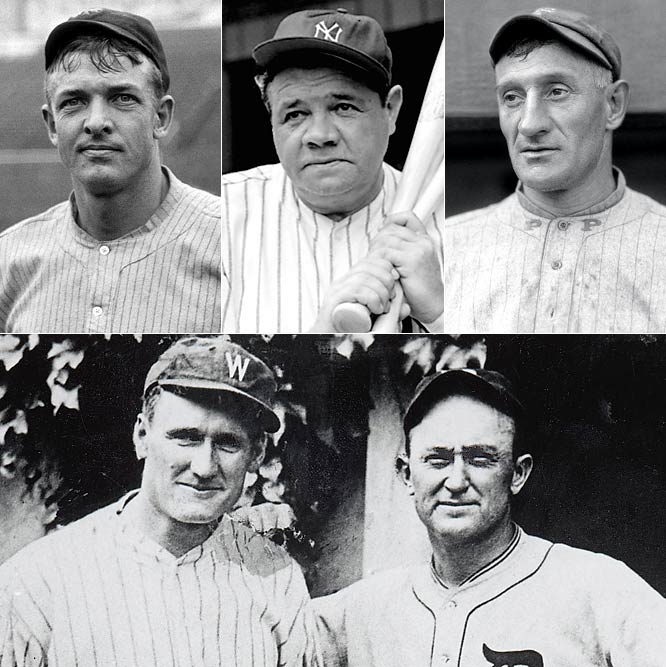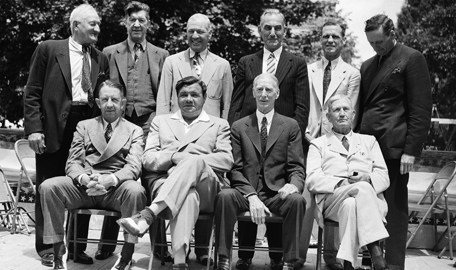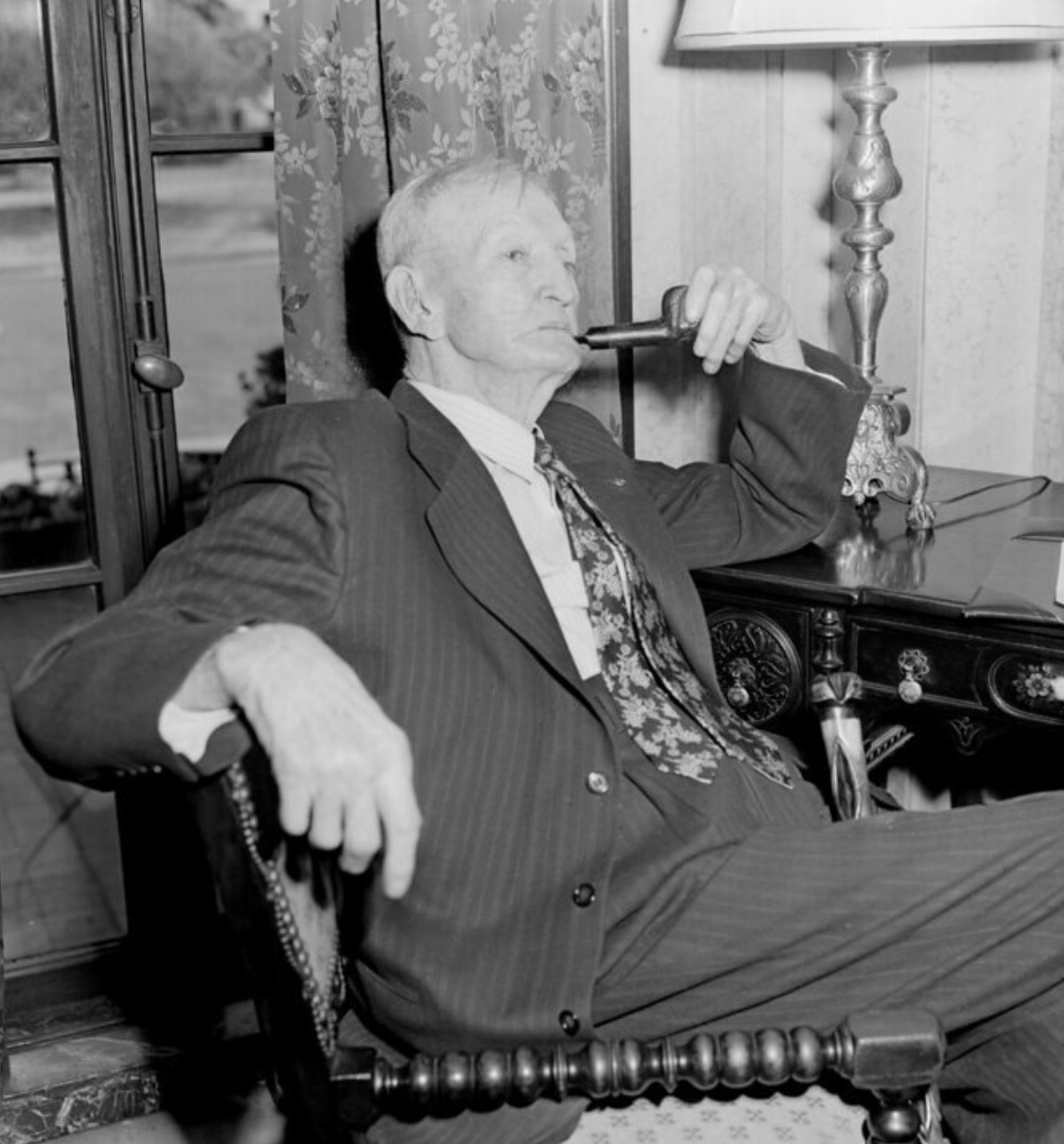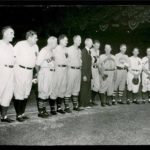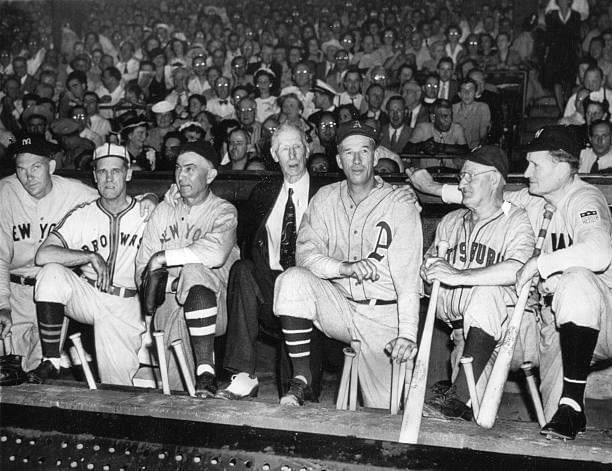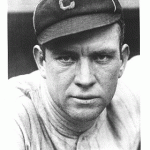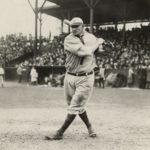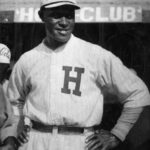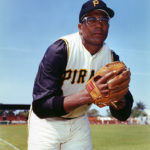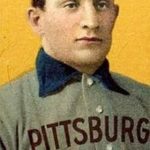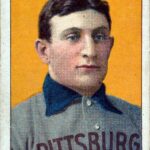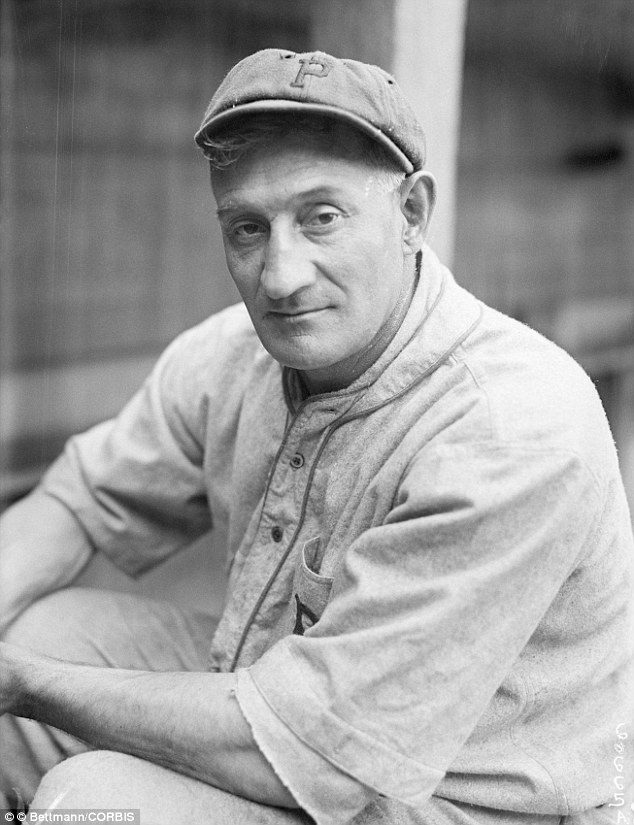Honus Wagner Essentials
Positions: Shortstop
Bats: R Throws: R
Height: Weight: 200
Born: February 24, 1874 in Chartiers, PA USA
Died: December 6, 1955 in Carnegie, PA USA
Buried: Jefferson Memorial Park, Pittsburgh, PA
Debut: July 19, 1897
Last Game: September 17, 1917 vs. BSN 0 AB, 0 H, 0 HR, 0 RBI, 0 SB
Hall of Fame: Inducted as Player in 1936. (Voted by BBWAA on 215/226 ballots)
Induction ceremony in Cooperstown held in 1939.
View Honus Wagner’s Page at the Baseball Hall of Fame (plaque, photos, videos).
Full Name: John Peter Wagner
Nicknames: The Flying Dutchman
View Player Bio from the SABR BioProject
Relatives: Brother of Butts Wagner
Nine Players Who Debuted in 1897
Roger Bresnahan
Honus Wagner
Rube Waddell
Chick Stahl
Jimmy Sheckard
Jack Dunn
Ed Abbaticchio
Tully Sparks
Bill Magee
The Honus Wagner Teammate Team
C: George Gibson
1B: Bill McKechnie
2B: Dots Miller
3B: Tommy Leach
SS: Joe Dolan
LF: Ginger Beaumont
CF: Max Carey
RF: Fred Clarke
SP: Deacon Phillippe
SP: Sam Leever
SP: Babe Adams
SP: Vic Willis
RP: Wilbur Cooper
M: Fred Clarke
Notable Events and Chronology for Honus Wagner Career
“Acknowledging that there may have been one or two whose talents were greater, there is no one who has ever played the game that I would be more anxious to have on a baseball team.” – Bill James, The Biographical Encyclopedia in 2000.
One of the first five players elected to the Baseball Hall of Fame, Honus Wagner is considered by some baseball historians to be the greatest all-around player in the history of the game. A versatile athlete who played every position but catcher during his 21-year career, Wagner was the dominant player of his time, capturing eight batting titles over a 12-year stretch and leading the National League in numerous other statistical categories as well during the first decade of the 20th century. One of Wagner’s greatest admirers was New York Giants longtime manager John McGraw, who said of The Flying Dutchman, “He was the nearest thing to a perfect player, no matter where his manager chose to play him.“
Biography:
Johannes Peter Wagner was born to German immigrants Peter and Katheryn Wagner in Mansfield, Pennsylvania on February 24, 1874. One of six surviving children (three of the couple’s children died in infancy), Johannes was raised in the adjacent town of Chartiers, just a few miles from Pittsburgh. Big, clumsy, and bowlegged as a child, Johannes soon acquired the nickname of Hans or Honus, which was a moniker usually reserved for awkward children. Honus dropped out of school at age 12 to help his father and three older brothers in the coal mines. He also took jobs in steel mills before he eventually began to train at the side of his oldest brother, Charley, in the latter’s barber shop. The entire time, though, Wagner continued to hone his baseball skills by spending virtually every free moment playing ball with his four brothers on local teams.
Wagner’s barber shop training officially ended in 1893 when he began playing semipro ball with his older brother Albert in the Allegheny League. Future Hall of Fame manager and baseball executive Ed Barrow discovered the younger Wagner playing professional ball in the newly-formed Inter-State League two years later, and he quickly signed the 21-year-old infielder/outfielder to play for Paterson, New Jersey, in the Atlantic League. Splitting his time between first and third base the next two seasons, Wagner posted batting averages of .348 and .379, prompting the National League’s Louisville Colonels to acquire his rights early in 1897.
Wagner made his major league debut with Louisville on July 19, 1897, compiling a .335 batting average over the season’s final 61 games, while playing center field and also filling in at second base. Noting Wagner’s stout 5’11”, 200-pound frame, and also the surprising running speed he possessed for a man of his somewhat unusual proportions, the Louisville Commercial said he was built like “a one-story brick house, throws like a shot, and is remarkably fast.”
Perhaps the thing that the writer of the aforementioned article found most intriguing about Wagner’s running speed was that he was relatively fast in spite of his stocky and clumsy-looking appearance. Burly, bowlegged, and awkward-looking, Wagner hardly took on the the appearance of someone who possessed outstanding speed and agility. But he was an exceptional athlete who ran the bases extremely well and fielded his position better than most.
A November 19, 1907 article appearing in the New York American echoed the sentiments previously expressed by that Louisville sportswriter: “Nobody ever saw anything graceful or picturesque about Wagner on the diamond. His movements have been likened to the gambols of a caracoling elephant. He is ungainly and so bowlegged that when he runs his limbs seem to be moving in a circle after the fashion of a propeller. But he can run like the wind.”
After playing primarily center field in his first big league season, Wagner moved all over the infield and outfield the next two years, while posting batting averages of .299 and .341, respectively, and developing into one of the National League’s top offensive players. After finishing second in the league with 10 home runs in 1898, Wagner placed near the top of the league rankings in batting average, runs batted in (114), doubles (45), hits (196), slugging percentage (.501), and total bases (288) the following year.
The National League contracted from twelve to eight teams at the conclusion of the 1899 campaign, with the Colonels being one of the casualties. However, Louisville owner Barney Dreyfuss subsequently purchased half ownership of the Pittsburgh Pirates, bringing with him to Pittsburgh several of his former team’s best players, including Wagner.
The 26-year-old Wagner established himself as baseball’s best player upon his arrival in Pittsburgh. Playing most of his games in right field, Wagner placed among the league leaders with 100 runs batted in, 107 runs scored, 201 hits, and 38 stolen bases, and he won his first batting title with a mark of .381, while also topping the circuit with 22 triples, 45 doubles, and a .573 slugging percentage. The versatile Wagner garnered significant playing time at shortstop in each of the next two seasons, before moving to the position permanently in 1903. All the while, though, he continued to excel at the plate. Wagner batted .353, scored 101 runs, and led the National League with 49 stolen bases and a career-high 126 RBIs in 1901. He followed that up by posting a .330 batting average in 1902, while leading the league with 91 runs batted in, 105 runs scored, 30 doubles, and 42 steals. After moving to shortstop full-time in 1903, Wagner captured his second batting championship with a mark of .355, while also topping the circuit with 19 triples.
Although Wagner lacked grace in the field, he used his range and powerful throwing arm to establish himself as arguably baseball’s finest defensive shortstop. Sporting Life reported: “Wagner is as graceful at short as a steam roller. Yet the clumsy galoot manages to get all over the infield and lays hands on everything that is batted, high or low.”
Giants manager John McGraw claimed that Wagner had a “sixth sense of baseball.” He described the Pirates shortstop as someone who knew just where to play certain hitters on certain pitches. Wagner played deep at shortstop and used a glove with the palm cut out for better control. Using his stubby hands like scoops and often picking up dirt and pebbles with the ball, he waited until the last second to release the ball, before nipping the runner at first base with his powerful throwing arm. Expressing his admiration for the shortstop’s versatility, McGraw proclaimed, “Wagner is a whole team in himself.”
Wagner remained the National League’s best player throughout the remainder of the decade, winning five of the next six batting titles, and finishing a close second with a mark of .363 the other time. He had perhaps his greatest all-around season in 1908, when he led the league in nine different offensive categories, including batting average (.354), runs batted in (109), hits (201), triples (19), doubles (39), and stolen bases (53). His 10 home runs left him just two short of capturing the coveted triple crown.
Wagner’s exceptional play enabled the Pirates to establish themselves as one of baseball’s dominant teams during the first decade of the 20th century. They won the National League pennant in 1901, 1902, 1903, and 1909, and they finished no lower than fourth in any season from 1900 to 1911. The Pirates lost the first-ever World Series to the American League champion Boston Americans in 1903. However, they defeated Ty Cobb’s Detroit Tigers in the 1909 Fall Classic, with the 35-year-old Wagner badly outplaying the 22-year-old Tiger great. Cobb batted a mere .231 during the seven-game Series, which was won by Pittsburgh. Meanwhile, Wagner batted .333 and stole six bases.
Wagner continued to perform exceptionally well until 1913, when Father Time finally began to catch up to him. Yet, he still managed to hit .300 in somewhat limited action that year, thereby surpassing the .300-mark for the fifteenth consecutive season. Wagner’s batting average slipped to just .252 the following year, and he failed to bat any higher than .287 in any of his three remaining years in the league. After appearing in only 74 games for the Pirates in 1917, the 43-year-old Wagner announced his retirement at season’s end. He finished his career with a .328 batting average, 1,733 runs batted in, 1,739 runs scored, 3,420 hits, 252 triples, 643 doubles, and 723 stolen bases. At the time of his retirement, Wagner had more hits, runs batted in, runs scored, stolen bases, and total bases than any other player in history, to that point. Although he compiled many of his numbers while playing other positions, Wagner still has more hits, doubles, triples, RBIs, and stolen bases than any other shortstop who ever played, and his .328 career batting average is also the highest of any player who ever manned the position. In addition to winning eight batting titles, Wagner led the National League in runs batted in and stolen bases five times each, slugging percentage and total bases six times each, doubles seven times, triples three times, and runs scored and hits twice each. He knocked in more than 100 runs nine times, scored more than 100 runs seven times, batted over .350 six times, stole more than 50 bases on five separate occasions, and accumulated more than 20 triples and 200 hits two times each.
Following his playing career, Wagner served as a coach on the Pirates for 39 years, instructing future Hall of Famers such as Arky Vaughan, Paul and Lloyd Waner, Pie Traynor, and Ralph Kiner in the finer points of the game. He also coached college baseball and basketball, served as deputy county sheriff in Allegheny County, Pennsylvania for a time, and ran a well-known sporting goods company. Wagner was elected to the Baseball Hall of Fame in 1936, along with fellow immortals Ty Cobb, Babe Ruth, Walter Johnson, and Christy Mathewson. Only Cobb received more votes than Wagner, who tied Ruth for second place in the initial Hall of Fame balloting. Wagner spent the remainder of his life in Pittsburgh, eventually passing away on December 6, 1955 at the age of 81.
Although Ty Cobb finished ahead of Wagner in the voting for the Hall of Fame, many baseball experts considered The Flying Dutchman to be the superior all-around player. John McGraw, who was perhaps Wagner’s greatest admirer, told The Sporting News in 1955, “I name Wagner first on my list, not only because he was a great batting champion and base-runner, and also baseball’s foremost shortstop – but because Honus could have been first at any other position, with the possible exception of pitcher. In all my career, I never saw such a versatile player.”
More than 50 years after his passing, and almost 100 years after he played his last game, Honus Wagner is still considered by most baseball historians to be the greatest shortstop ever to play the game. And there are those who still consider him to be among the handful of greatest players of all-time.
Noted baseball historian and author Bill James wrote of Wagner in The Biographical Encyclopedia in 2000, “Acknowledging that there may have been one or two whose talents were greater, there is no one who has ever played the game that I would be more anxious to have on a baseball team.”
QUOTES:
“He was the nearest thing to a perfect player no matter where his manager chose to play him.” – John McGraw
” . . . there is no one who has ever played the game that I would be more anxious to have on a baseball team.” – Bill James
“The greatest ball player of all time.” – John McGraw
“Acknowledging that there may have been one or two whose talents were greater, there is no one who has ever played the game that I would be more anxious to have on a baseball team.” – Historian / Author Bill James in The Biographical Encyclopedia (2000)
“Chuck him the ball as hard as you can… and pray.” – John McGraw in George Plimpton’s Out of My League (2003)
“He was a gentle, kind man, a storyteller, supportive of rookies, patient with the fans, cheerful in hard times, careful of the example he set for youth, a hard worker, a man who had no enemies and who never forgot his friends. He was the most beloved man in baseball before Ruth.” – Historian / Author Bill James
“I name Wagner first on my list, not only because he was a great batting champion and base-runner, and also baseball’s foremost shortstop – but because Honus could have been first at any other position, with the possible exception of pitcher. In all my career, I never saw such a versatile player.” – John McGraw in The Sporting News (December 6, 1955)
“I think he was so well put together and his system so well adjusted that his bodily functions were near to perfection. This is especially remarkable because for several years, starting at age twelve, he worked in a mine near his hometown of Mansfield, Pennsylvania, new renamed Carnegie.” – Author Fred Lieb in Baseball As I Have Known It (1996)
“It is hoped that Louisville didn’t throw away very much money on the Wagner deal, as times are had and Wagner won’t set the world afire as a third baseman. He is a better outfielder than infielder.” – Sporting Life (July 24, 1897)
“Nobody ever saw anything graceful or picturesque about Wagner on the diamond. His movements have been likened to the gambols of a caracoling elephant. He is ungainly and so bowlegged that when he runs his limbs seem to be moving in a circle after the fashion of a propeller. But he can run like the wind.” – New York American (November 19, 1907)
“One day he was batting against a young pitcher who had just come into the league. The catcher was a kid, too. A rookie battery. The pitcher threw Honus a curveball, and he swung at it and missed and fell down on one knee. Looked helpless as a robin. I was kind of surprised, but the guy sitting next to me on the bench poked me in the ribs and said, ‘Watch this next one.’ Those kids figured they had the old man’s weaknesses, you see, and served him up the same dish-as he knew they would. Well, Honus hit a line drive so hard the fence in left field went back and forth for five minutes.” – Burleigh Grimes in The Quotable Baseball Fanatic (2004)
“One of Five Immortals elected to Cooperstown in the inaugural-year balloting, Wagner had his lack of flair and extravagant anecdotes to blame for later-day wonder that some early-century spectactors regarded him as superior to Ty Cobb.” – Authors Donald Dewey & Nichols Acocella in The Biographical History of Baseball (1995)
“Spike Honus Wagner? It would have taken quite a foolhardy man.” – Ty Cobb in My Life in Baseball (1993)
“There is something Lincolnesque about him, his rugged homeliness, his simplicity, his integrity, and his true nobility of character.” – Sportswriter Arthur Daley
“The way to get a ball past Honus is to hit it eight feet over his head.” – John McGraw inThe Biographical Encyclopedia (2000)
“With his huge hands and quick moves he was considered the premier shortstop of the era and probably the best of all time given the size of the gloves and player surfaces.” – Jonathan Fraser Light in The Cultural Encyclopedia of Baseball (1997)
“You can have your Cobbs, your Lajoies, your Chases, your Bakers, but I’ll take Wagner as my pick of the greatest. He is not only a marvelous mechanical player, but he has the quickest baseball brain I have ever observed.” – John McGraw
Quotes By Wagner:
“I don’t make speeches. I just let my bat speak for me in the summertime.” Source: Dr. Freeman in The Wisdom of Old-Time Baseball (1996)“I don’t want my picture in any cigarettes, but I also don’t want you to lose the ten dollars, so I’m enclosing my check for that sum.” Source: Bennett Cerf in The Laugh’s on Me (1959)
“In all my years of play, I never saw an ump deliberately make an unfair decision. They really called them as they saw ’em.” Source: Jack Sher in Sport Magazine’s All-Time All Stars (1977)
“I never have been sick. I don’t even know what it means to be sick. I hear other players say they have a cold. I just don’t know what it would feel like to have a cold – I never had one.” Source: Fred Lieb in Baseball As I Have Known It (1996)
“I won’t play for a penny less than fifteen hundred dollars” Source: Paul Dickson in Baseball’s Greatest Quotations (1992)
“Keeler could bunt any time he chose. If the third baseman came in for a tap, he invariably pushed the ball past the fielder. If he stayed back, he bunted. Also, he had a trick of hitting a high hopper to the infielder. The ball would bounce so high that he was across the bag before he could be stopped.” Source: 50th Anniversary Hall of Fame Yearbook (1989)
“There ain’t much to being a ballplayer, if you’re a ballplayer.” Source: The Cultural Encyclopedia of Baseball (1997)
“Things were changing fast by that time, women were beginning to come to the ball parks. We had to stop cussing.” Source: Jack Sher in Sport (June 1949)
@ET-DC@eyJkeW5hbWljIjp0cnVlLCJjb250ZW50IjoicG9zdF90YWdzIiwic2V0dGluZ3MiOnsiYmVmb3JlIjoiTGVhcm4gTW9yZSBhYm91dCB0aGUgdGVhbXMsIHBsYXllcnMsIGJhbGwgcGFya3MgYW5kIGV2ZW50cyB0aGF0IGhhcHBlbmVkIG9uIHRoaXMgZGF0ZSBpbiBoaXN0b3J5IC0gLSAtIC0gLSAtIC0gIiwiYWZ0ZXIiOiIiLCJsaW5rX3RvX3Rlcm1fcGFnZSI6Im9uIiwic2VwYXJhdG9yIjoiIHwgIiwiY2F0ZWdvcnlfdHlwZSI6InBvc3RfdGFnIn19@
Factoids, Quotes, Milestones and Odd Facts
Played For
Louisville Colonels (1897-1899)
Pittsburgh Pirates (1900-1917)
Managed
Pittsburgh Pirates (1917)
Similar: Offensively, Nap Lajoie was a similar player.
Linked: Fred Clarke, Ty Cobb, Pie Traynor
Best Season, 1908
Wagner had a lot of great seasons, but we’ll settle on 1908. The Bucs finished one game back in the pennant race, but Wagner did his share to keep them in the hunt. He won his sixth batting title (.354), paced the league in slugging, OBP, OPS, hits, total bases, doubles, triples, RBI and steals. He was at the top of his game. He had a similar season in 1909, winning the batting crown again.
Post-Season Appearances
1903 World Series
1909 World Series
Description
Detroit sportswriter H.G. Salsinger wrote of Wagner’s “long, beaked nose, the protruding cheekbones, the powerful and bowed legs, the ham-like fists that smothered groundballs.”
Factoid
Honus Wagner pitched in two games: one in 1900 and the other in 1902. Though he walked six batters in his eight innings, Hans did not allow a run, leaving him with a nifty 0.00 career ERA.
Where He Played: Shortstop (1,887 games), outfield (372), first base (248), third base (209), second base (57), pitcher (2). Wagner is generally considered to be the greatest shortstop in major league history.
Minor League Experience
1895: Steubenville (Inter-State League)
1895: Mansfield (Ohio State League)
1895: Adrian (Michigan State League)
1895: Warren (Iron-Oil League)
1896-1897: Paterson (Atlantic Coast League)
Feats: Three times in his career Wagner stole second, third, and home in the same inning. He did it in 1902, 1907, and 1909… In 1914, on June 9th, Wagner hit for the cycle.
Milestones
On June 9, 1914, Wagner collected his 3,000th hit, a double off Philadelphia’s Erskine Mayer.
Notes
Few awards existed when Wagner was at his peak. He did finish second in National League MVP voting in 1912, when he was 38 years old. Had there been an MVP award during his prime, he may have won as many as eight… Wagner was one of the first five inductees to the Hall of Fame in 1936.
Hitting Streaks
23 games (1901)
23 games (1901)
Transactions
In the winter of 1899-1900, the National League was reduced from 12 to eight teams. Louisville Colonels owner Barney Dreyfuss became Pittsburgh Pirates club president and was forced to build a team from the bottom up. To speed the process, Dreyfuss brought Wagner with him. Based on that information alone, the man must have been a genius.
Most Career Hits, Brothers
1. Paul and Lloyd Waner… 5,611
2. Felipe, Matty, and Jesus Alou… 5,094
3. Joe, Dom, and Vince DiMaggio… 4,853
4. Ed, Jim, Frank, Joe, and Tom Delahanty… 4,211
5. Hank and Tommy Aaron… 3,987
6. Cal Jr. and Billy Ripken… 3,858
7. Roberto and Sandy Jr. Alomar… 3,627
8. Joe and Luke Sewell… 3,619
9. Ken, Clete and Cloyd Boyer…3,559
10. Honus and Butts Wagner… 3,489
11. Bob and Roy Johnson… 3,343
12. Eddie and Rich Murray… 3,299
Factoid
In 1909, Honus Wagner appeared in a short film that showed him giving batting tips to a young baseball player. That youngster grew up to play “Moe” in “The Three Stooges” comedy team.
Factoid
In 1905, Honus Wagner signed the first endorsement contract with a bat company. His deal with Hillerich & Bradsby, Co. called for them to supply Wagner with Louisville Slugger bats to his specifications. In return, the bat company branded Wagner’s name on their bats and sold them to eager fans. Since Wagner’s deal, more than 8,500 players have had their names on a Louisville Slugger.
Replaced
Wagner was a jack-of-all-trades in his first four seasons in the big leagues. In 1898 he ended up the Colonels regular first baseman half-way through the season, but the next year he was at third, filling in for the injured Tommy Leach.
Replaced By
Amazingly, at the age of 42 in 1916, Wagner was still a good starting shortstop for the Pirates, fielding 16 points above the league average in 92 games. The next season, Pittsburgh brought in 22-year old Charlie “Chuck” Ward to start at short. Ward his a meager .236 in 125 games and committed 50 errors for a .912 fielding average. He was traded to Brooklyn in a deal that brought over George Cutshaw and Casey Stengel. Ward never played regularly again in his six-year career.
Best Strength as a Player
Hitting, running, fielding, throwing.
Largest Weakness as a Player
None
Other Resources & Links

